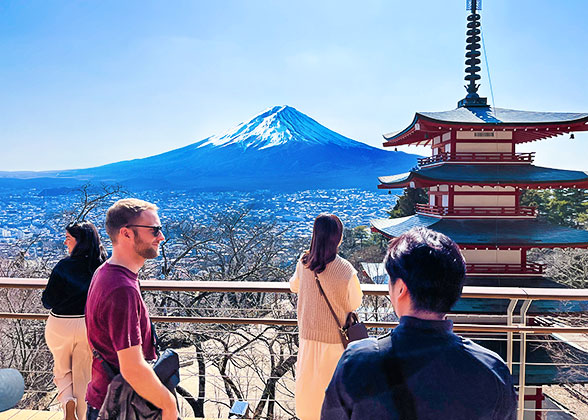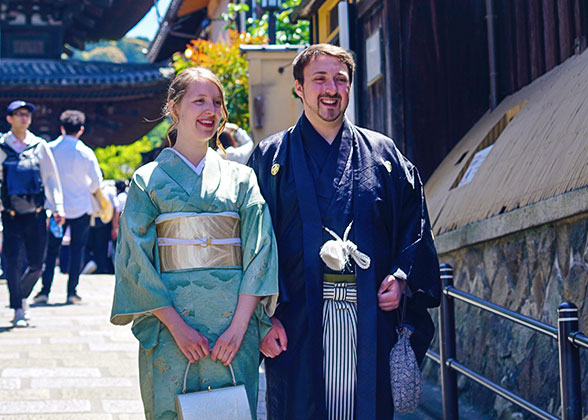Mount Fuji – the Holy Mountain in Japan
Basic Facts:

Lake Kawaguchi Photos ( 20
|
Mount Fuji is one of the classic symbols of Japan, and the summit is covered with snow all year round. Mt. Fuji has been considered as a sacred mountain with natural charm and religious solemnness in the heart of Japanese. Around its foothills, there are five freshwater lakes collectively known as the Fuji Five Lakes, which are the best places for mountain viewing. The 5th Station is also popular halfway up the mountain.
Mt. Fuji Weather & Best Time to Visit
The spring month April with luxuriant cherry blossoms and the autumn month November with stunning fall foliage are the best time to visit Mt. Fuji. The sceneries are breathtakingly spectacular in the pleasingly mild weather.Summer time, from early July to early September, is the open season for mountaineering to the summit. Thus, the two months become a hot time to adventure on the trekking trails.
Mount Fuji Weather by Month

Distant View of Mt. Fuji
|
Mt. Fuji 5th Station
From the foot to the top of the mountain, Mt. Fuji is divided into 10 stages. In the right middle, 2,305 meters (7,562 feet) high, the leisure platform is called the 5th Station, where many restaurants and souvenir shops are available. It is the highest point that tourist buses can reach, as well as the starting point of climbing to the summit.As the attraction with the largest number of tourists gathering, Mt. Fuji 5th Station is opened throughout the year, and becomes the must-see on Mount Fuji. You can get a bird’s eye view of the mountain there, and look up into the crater in a special angle of view.
Where to Enjoy the Fine View of Mt. Fuji
Generally speaking, looking the mountain far into the distance is very welcomed and is the major way to visit Mt. Fuji. Nearby areas at the foot of Mt. Fuji are the first choices. Fuji Five Lakes especially Lake Kawaguchi and Lake Ashi in Hakone are the top places for viewing, meanwhile Arakurayama Sengen Park, Oshino Hakkai, Fuji-Q Highland, etc. are all hot sites. In the cities of Tokyo and Yokohama, you can also see the snow-capped mountain on a skyscraper when it is clear.
|
|
|
When can I climb Mt. Fuji?
During usual time, you can go up to Mt. Fuji 5th Station. The trails to the crater are opened from early July to early September, in particular, late July to late August, the time after rainy season and before typhoon season, is the peak time for climbing the mountain.The Fujinomiya Trail, Yoshida Trail, Subashiri Trail, and Gotemba Trail go straight to the summit, while Yoshida Trail is the most-visited with completed facilities like rest stop, first aid station, exclusive ascending and descending ways.
Tips for Climbing Mt. Fuji
![]() It is cooler on Mt. Fuji than the mountain foot, so wear a little thicker when going up the mountain, especially when hiking during night. To the crater, keeping warm is more important as there would be strong winds and lower temperature.
It is cooler on Mt. Fuji than the mountain foot, so wear a little thicker when going up the mountain, especially when hiking during night. To the crater, keeping warm is more important as there would be strong winds and lower temperature.
![]() If you need an accommodation overnight on the mountain, please make a reservation of the huts in advance.
If you need an accommodation overnight on the mountain, please make a reservation of the huts in advance.
![]() It is easy to get altitude sickness on Mt. Fuji, so prepare some medicines, portable oxygen tanks, and so on to prevent it.
It is easy to get altitude sickness on Mt. Fuji, so prepare some medicines, portable oxygen tanks, and so on to prevent it.
![]() Pay close attention to the local weather, and plan your trip on a great day.
Pay close attention to the local weather, and plan your trip on a great day.

Mt. Fuji with Lake Kawaguchi
|
How to get to Mt. Fuji?
1. Highway Buses to Mt. Fuji or the Lake Kawaguchi are available from Tokyo, Narita Airport, Haneda Airport, Yokohama, Osaka and Kyoto.2. Trains to Kawaguchiko (Lake Kawaguchi) station is also a great way to reach Mt. Fuji. For example, the limited express train Fuji Excursion from Chiba to Kawaguchiko, via Shinjuku station in Tokyo downtown, is very convenient.
3. You can also drive to Mt. Fuji by yourself from the nearby cities, with the valid driving license and a rented car.
|
|
|
Mt. Fuji Photos & Mt. Fuji Videos





